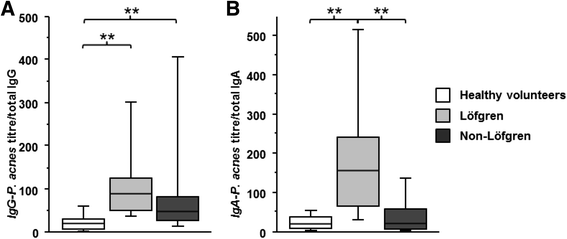Immune response to Propionibacterium acnes in patients with sarcoidosis--in vivo and in vitro
- PMID: 26204953
- PMCID: PMC4513400
- DOI: 10.1186/s12890-015-0070-7
Immune response to Propionibacterium acnes in patients with sarcoidosis--in vivo and in vitro
Abstract
Background: Propionibacterium acnes was found in lungs and lymph nodes of patients with sarcoidosis and may induce hypersensitivity type granuloma formation. Data regarding the immune response to P. acnes of European sarcoid patients are scarce.
Methods: We assessed the total IgG and IgA amount and specific antibodies to P. acnes and to Staphylococcus aureus, serving as a control, in BAL fluid of 64 patients with sarcoidosis and of 21 healthy volunteers. In a subcohort of sarcoid patients and controls, TNF-α and GM-CSF production of BAL cells stimulated with heat-killed P. acnes were measured.
Results: In sarcoid patients, the total IgG and IgA levels in BAL fluid were significantly elevated compared to healthy volunteers. IgG and IgA titres against P. acnes and S. aureus were increased in sarcoid patients, yet based on the total amount of antibodies, only antibodies directed against P. acnes were relatively and significantly increased. Furthermore, BAL cells of sarcoid patients produced significantly more TNF-α and GM-CSF upon stimulation with heat-killed P. acnes compared to controls.
Conclusions: Patients with sarcoidosis had elevated levels of specific antibodies against P. acnes which suggest contact with this bacterium in the past. Furthermore, BAL cells of sarcoid patients produced inflammatory cytokines (TNF-α and GM-CSF) upon stimulation with P. acnes indicating potential involvement of this pathogen in the pathogenesis of sarcoidosis in some patients.
Figures



References
Publication types
MeSH terms
Substances
LinkOut - more resources
Full Text Sources
Other Literature Sources
Miscellaneous

